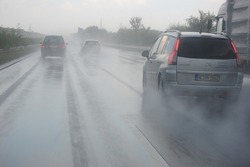
Hydroplaning often happens when water pressure pushes water underneath a car’s tire causing loss of traction and control, and motorists must take active steps to reduce the possibility of skidding, skipping and slipping that can cause an accident. Hydroplaning can occur when even a small amount of water is present on the road surface.
Tips for Preventing Hydroplaning & Automobile Accidents
Tires should be in good condition and properly inflated. If tires are bald or the tread has worn thin in some places, they won’t be able to maintain a solid connection with the road surface.
Drivers should pay particular attention during the first 10-15 minutes of a light rain. During these times, oil, rubber, and other non-water soluble contaminants on the road float to the surface, increasing the risk of hydroplaning and having an automobile accident.
Motorists should keep brakes in good repair and adjust braking habits during rain or when snow/ice melts. Drivers should slow down and allow extra time to come to a complete stop when approaching intersections.
Roads are generally graded to allow drainage towards the outer lane and excess water tends to accumulate in these areas during heavy rain or melt cycles. However, this is not always the case and some lanes are graded towards the center. Motorists should pay close attention to where the water accumulates on the roads they travel when it starts to rain.
Drivers should also avoid using cruise control in rainy, wet conditions. Doing so allows drivers to adjust speed more effectively as conditions on the road surface change.
If a driver goes into a skid and starts to hydroplane while driving, it’s always best to avoid hard braking. Instead, drivers should let off on the gas and steer the vehicle in the direction of the skid. As the vehicle slows, drivers should tap the brakes to break the surface tension of the water which will then allow the tire to make contact with the road surface and bring the vehicle back under control.
It’s also important to avoid hard turns during rainy, slushy, and bad weather conditions. During this simple maneuver, the water can pull the vehicle out of the lane of travel and into sidewalks, walls, light posts, and other traffic lanes.

